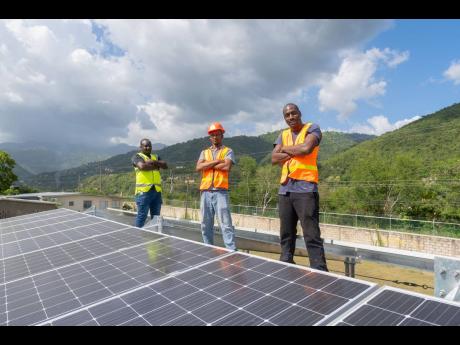Sir John Golding Rehabilitation Centre, a sun-powered success story
For 67 years, Sir John Golding Rehabilitation Centre, the only integrated treatment and rehabilitation facility for people with physical disabilities in Jamaica was almost exclusively powered by fossil fuels. The lone exception was its sun-powered water heaters.
But two years ago, the rehabilitation centre installed a grid-tied solar photovoltaic (PV) system with solar panels nailed to the roof of a meeting room, and all incandescent bulbs were switched out for energy efficient LEDs.
It was one of three public hospitals retrofitted with LED and grid tied PV systems in a bid to lower energy bills and produce a lighter national carbon footprint. The other hospitals were May Pen and the National Chest Hospital.
Rehabilitation operations must use power equipment and facilities for the treatment of spinal cord injuries, cerebral palsy, congenital deformities, as well as orthopaedic conditions and amputations. The Rehab Centre’s solar system started to generate 1694-kilowatt (kWh) hours or 1.6 megawatt hours in one month (May 2021), mere weeks after it was commissioned.
Nearly two years later, in April 2023, the system was producing 1786 kWh in one month. Just one month later in May 2023, generation had increased to 1925 kWh, that’s nearly two megawatt (MWh) hours. App readings prove the solar system had channelled a combined 3.7 MWh of solar power to the hospitals in those two months.
Energy generation
If this level of energy generation remains constant, the solar system will produce 16 800 kWh in 2023, Yannis Varkas, engineer at Enviroearth, the company contracted to supply, install and monitor the PV system, said.
He said this means the Rehab Centre is on target to generate over 50 per cent in excess of the annual 10 000-kWh projected before installation, and believes that the centre might also have the option to resell energy to the Jamaica Public Service company in the event of excess supply.
And if the current trends continue, it can save approximately $1.5 million in energy bills for 2022 and 2023 combined.
Senior medical officer at the centre, Dr Rory Dixon, said rising fuel charges and inflation have increased electricity bills, and costs would have been higher without the solar systems. “We normally don’t get everything we ask for in terms of a budget. So, energy savings help us meet the basic demands,” he said. He is now advocating for an expansion of the renewable energy project so energy savings can be channelled into well-needed infrastructural development.
These results reflect the impact of the Renewable Energy and Improvement of Energy Efficiency in the Public-Sector project implemented 2016 to 2021 by United Nations Development Programme Multi Country Office in Jamaica in partnership with the Ministry of Health and Wellness and the Ministry of Science, Energy, Telecommunications and Transport. The project was funded by the Global Environment Facility (GEF) with a US$1.25 million grant.
Maintenance supervisor, Damion Lawrence, is one of two electricians at Sir John Golding Rehabilitation Centre who benefitted from the capacity building of 32 health sector personnel.
He said monitoring is now easier because it is all automated and the team is able to observe energy savings remotely using the online platform.
“This facility (Sir John Golding Rehabilitation Centre) uses most of its energy during the day so the grid type would have been the best. We are appreciative of what has been installed here,” he said, “A lot of times we … supervisors … say we need to do this, and it hasn’t been done, but now the CEO and (leaders) are realising that this is the way to go,” he noted.
Up to 2012, Jamaica’s health sector accounted for six per cent of the total public sector electricity bill at a cost of US$10.2 million and 30 gWh (gigawatt hours) per year of energy consumption. In 2021, the inmister of science, energy, telecommunications and transport, Daryl Vaz, projected a 22-per-cent annual decline in the public health sector bill arising from the GEF investment.
The ministry reports that up to 2020, about 18 per cent of current electricity demand was being met by renewables.


